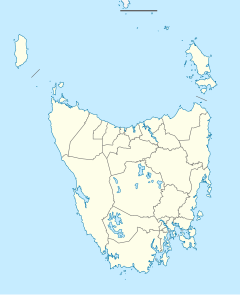Douglas Apsley National Park
| Douglas-Apsley National Park | ||
|---|---|---|
|
|
||
| Location: | Tasmania , Australia | |
| Specialty: | Ravines | |
| Next city: | Bicheno | |
| Surface: | 160.8 km² | |
| Address: |
Douglas-Apsley National Park via Freycinet National Park Office Private Bag Bicheno TAS 7215 |
|
The Douglas-Apsley National Park is a national park on the east coast of the Australian state of Tasmania . It is located northeast of Hobart and just a few kilometers northwest of the coastal town of Bicheno . The park covers 16,080 hectares and was placed under protection in 1989.
General
Douglas Apsley National Park is one of Tasmania's newer national parks and includes the catchment areas of the three rivers Apsley River , Denison Rivulet and Douglas River .
Sights include deep gorges, waterfalls, dry eucalyptus forests , but also rain and hardwood forests and heathlands. The climate is very mild and characterized by the eastern location of the island. Visitors can take short walks as well as long day hikes over several days.
history
Although the area is wild and difficult to access, it was criss-crossed by paths from the mid-19th century that were used to develop mineral resources. Coal was mined for over 100 years. The different uses by farmers, trappers and mining probably prevented large-scale deforestation, which is why a forest landscape with a unique diversity of plant and animal species could be preserved here.
Animal species
There are several remarkable bird species in the national park, such as B. Tasmanian Nativehen , Green Rosella , the Honigfresser types yellow Kehl-Honigfresser , Schwarzkopf Honigschmecker , Stark beak Honigschmecker , yellow wattlebird , the stem Skitterer (Acanthornis magna), the South Sea grass mosquito species Acanthiza ewingii and Sericornis humilis, the Tasmanwürgerkrähe and Schnäpperarten Tasmanschnäpper , Flammenbrustschnäpper and Rose breast -Catcher .
See also
Web links
- Official on the park (Engl.)
Individual evidence
- ↑ Information on the tourism website
- ↑ General statements by the National Park Administration
- ↑ Significance of the area according to the national park administration
- ↑ Information according to birddata.com of October 24, 2011
